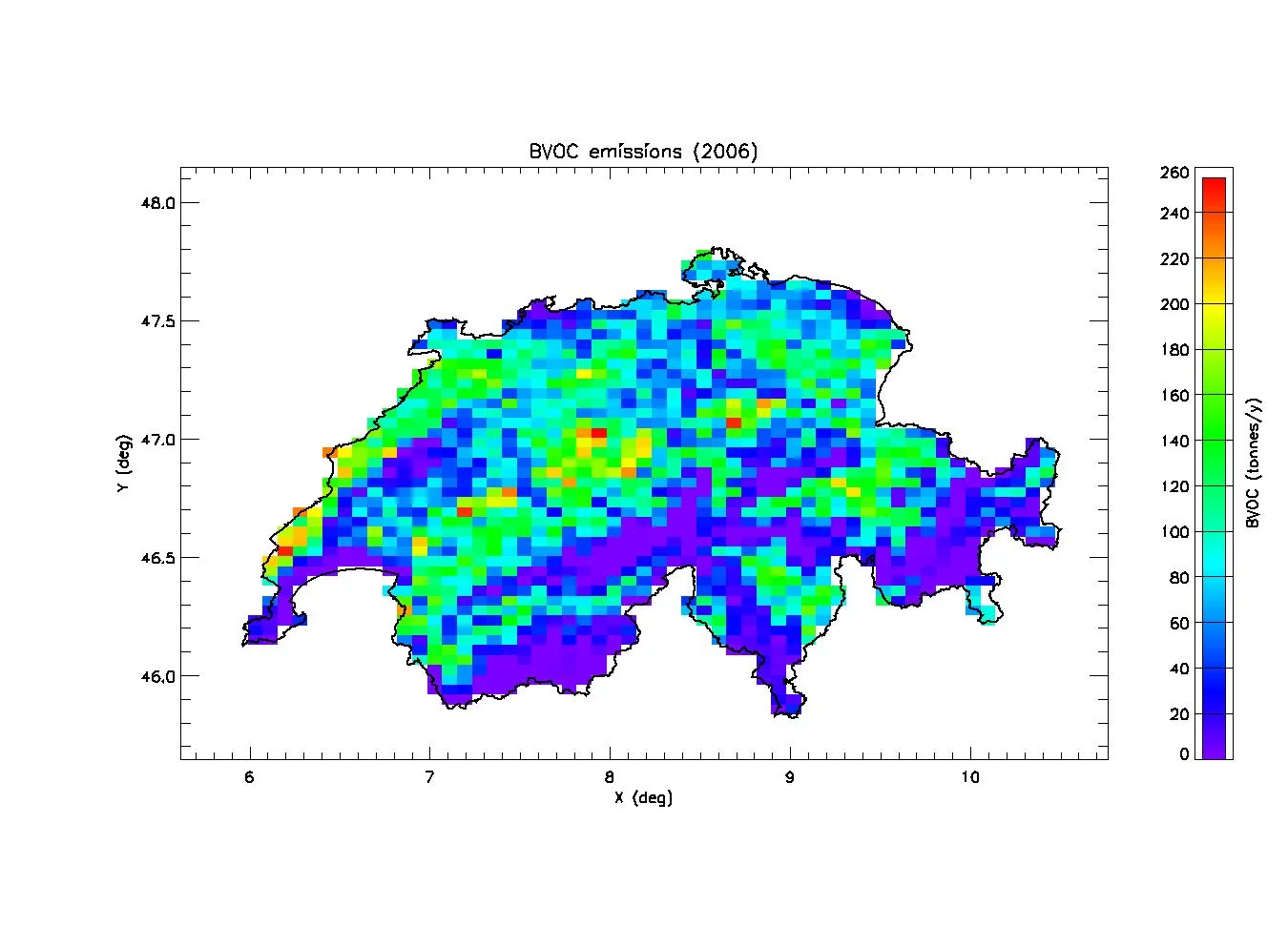Chemical Transport Model CAMx
(Comprehensive Air Quality Model with eXtensions)
CAMx (Comprehensive Air Quality Model with Extensions) is an Eulerian photochemical dispersion model that allows for an integrated “one-atmosphere“ assessment of gaseous and particulate air pollution over many scales ranging from urban to regional (ENVIRON International Corporation, http://www.camx.com). CAMx simulates the emission, dispersion, chemical reactions, and removal of pollutants in the lower troposphere by solving the pollutant continuity equation for each chemical species on a system of nested three-dimensional grids.
Gas-phase chemistry
Various gas-phase mechanisms are supported in CAMx. These are Carbon Bond Mechanism IV (Gery et al., 1989), CB05 (Yarwood et al., 2005), CB6, SAPRC99 chemical mechanism (Carter, 2000). We are using CB6 with aerosol chemistry.
Aerosol chemistry
CAMx provides two options for treating aerosol size distributions: the CF scheme and CMU scheme. The CF scheme divides the size distribution into two static modes (coarse and fine). Primary species are modeled as fine and/or coarse particles, while all secondary species are modeled as fine particles only. The CMU scheme employs a sectional approach that dynamically models the size evolution of each aerosol constituent across a number of fixed size sections. The user defines the number of size sections and their size ranges.
In CAMx, aerosol processes are linked to all gas-phase mechanisms. The gas-phase photochemistry forms aerosol precursors via the OH initiated oxidation of SO2 to sulfate, production of nitric acid, and formation of condensable organic gases. The aerosol precursors are supplied to aerosol chemistry, which performs the following processes:
- aqueous sulfate and nitrate formation in resolved cloud water using RADM aqueous chemistry algorithm (Chang et al., 1987)
- partitioning of condensable organic gases (CG) to secondary organic aerosols (SOA) to form a condensed organic solution phase using a semi-volatile equilibrium scheme called SOAP (Strader et al., 1999)
- partitioning of inorganic aerosol constituents (sulfate, nitrate, ammonium, sodium, and chloride) between the gas and particle phases using the ISORROPIA thermodynamic module (Nenes et al., 1998)
- uptake of nitric acid by calcium in soil dust particles is calculated external to ISORROPIA
In CAMx version 6.20, a hybrid 1.5 Dimensional Volatility Basis Set (VBS) approach for secondary organic aerosols has been added.
SOA module
The CAMx SOA module consists of two parts: gas-phase oxidation chemistry that forms condensable gases (CGs) and equilibrium partitioning between gas and aerosol phases for each CG/SOA pair. Anthropogenic SOA precursors are toluene and xylene. Biogenic SOA precursors are isoprene, monoterpenes and sesquiterpenes. Polymerization is also included. based on limited available data, it was assumed that SOA polymerized to a non-volatile form (i.e. moved permanently to the aerosol phase) with a lifetime of about 1 day. Polymerization slowly forms organic aerosol polymers called SOPA (anthropogenic) and SOPB (biogenic).
In CAMx version 6.20, a hybrid 1.5 Dimensional Volatility Basis Set (VBS) approach for secondary organic aerosols has been added.
Pollutant Removal
Trace gases and small particles are removed from the atmosphere via deposition to the surface. Dry deposition refers to the direct sedimentation and/or diffusion of material to various terrestrial surfaces and uptake into biota. Dry deposition of gases is based on the resistance models of Wesely (1989) and most recently Zhang et al.(2003). Surface deposition of particles occurs via diffusion, impaction and/or gravitational settling. The resistance approach used in UAM-AERO has been adopted in CAMx4. Wet deposition refers to the uptake of material via chemical absorption (gases) or nucleation/impaction into cloud water, and subsequent transfer to the Earth’s surface by precipitation. The efficiency of wet and dry deposition processes to remove pollutants from the air depends on the physical and chemical properties of the pollutants, local meteorological conditions, the type of surface on which they are being deposited, and on the frequency, duration, and intensity of precipitation events. The wet scavenging model implemented in CAMx4, calculates the following processes: wet scavenging of gases within and below precipitating clouds, wet scavenging of gases dissolved in cloud water, and in-cloud aerosols, and wet scavenging of dry particles.
Input and Output Files
CAMx requires inputs to describe photochemical conditions, surface characteristics, initial and boundary conditions, emission rates, and various meteorological fields over the entire modeling domain. Preparing this information requires several preprocessing steps to translate raw data to final input files. The model produces hourly average concentration output files, deposition and mass budget. We are using our own script CAMxRunner to perform CAMx simulations as well as input, output preparation in an efficient way (Oderbolz et al., 2012).
Particulate Source Apportionment Technology (PSAT)
CAMx has a tool for source apportionment of particles. PSAT is designed to source apportion both primary and secondary particles in CAMx.
References
Carter W.P.L., 2000. Programs and files implementing the SAPRC-99 mechanism and its associates emissions processing procedures for Models-3 and other regional models. January 31, 2000.
Chang J.S., R.A.Brost, I.S.A.Isaksen, S.Madronich, P.Middleton, W.R.Stockwell, and C.J.Walcek, 1987. A three-dimensional eulerian acid deposition model: Physical concepts and formulation, J. Geophys. Res., 92, 14,681-14,700.
Gery M.W., G.Z.Whitten, J.P.Killus, and M.C.Dodge, 1989. A Photochemical kinetics mechanism for urban and regional scale computer modeling. J. Geophys. Res., 94, 925-956.
Nenes A., C. Pilinis, ans S.N. Pandis, 1998. “ISORROPIA: A new thermodynamic model for multiphase multicomponent Inorganic aerosols” Aquatic Geochemistry, 4, 123-152.
Strader R., C. Gurciullo, S.N.Pandis, N.Kumar, and F.W.Lurmann, 1998. Development of gas-phase chemistry, secondary organic aerosol, and aqueous-phase chemistry modules for PM modeling. Final report for CRC Project A21-1 prepared for the Coordinating Research Council, Atlanta, GA by Sonoma Technology, Inc. Petaluma, CA, STI-97510-1822-FR, October.
Wesely M.L., 1989. Parameterization of surface resistances to gaseous dry deposition in regional-scale numerical models. Atmos. Environ., 23, 1293-1304.
Yarwood G., S. Rao, M. Yocke, G.Z. Whitten (2005). Updates to the Carbon Bond Chemical Mechanism : CB05. Final report prepared for US EPA. Available at http://www.camx.com/publ/pdfs/CB05_Final_Report_120805.pdf.
Zhang L., J.R. Brook and R. Vet. 2003. A revised parameterization for gaseous dry deposition in air-quality models. Atmos. Chem. Phys., 3, 2067-2082.
Contact Person
Sebnem Aksoyoglu
sebnem.aksoyoglu@psi.ch
Meteorological Model WRF
The Weather Research and Forecasting (WRF) Model is a next-generation mesoscale numerical weather prediction system designed to serve both operational forecasting and atmospheric research needs. It features multiple dynamical cores, a 3-dimensional variational (3DVAR) data assimilation system, grid and observation nudging, and a software architecture allowing for computational parallelism and system extensibility. WRF is suitable for a broad spectrum of applications for 2-way nested domains across scales ranging from meters to thousands of kilometers.
At LAC the Advanced Research WRF (WRF-ARW, Version 3.2.1) is used as the meteorological driver for the Air Quality model CAMx. Input data for WRF is provided by the WRF pre-processing System (WPS), which is controlled by global/regional forecasts or re-analyses. Currently ECMWF re-analyses with 0.72 deg and 3h resolutions are used. The WRF output is post-processed by the utility WRFCAMx, which converts the NetCDF data into the quantities and format required by CAMx.
WRF-ARW supports numerous projections. In previous air quality projects covering Central Europe , e.g. BAFU GOTHENBURG-2010, the lambert conical projection was used. Recent projects such as BAFU GOTHENBURG-2020, however, are extended to whole Europe, which require lon / lat coordinates to avoid geometric distortion. Since WRFCAMx does not support lambert to lon / lat transformation, the utility had to be modified. Current studies are based on 2 nested domains (whole Europe, Central Europe), the coarse domain having a spatial resolution of 0.250 deg (lon) and 0.125 deg (lat).
The WRF package runs on Cray XT5 (rosa.cscs.ch) at the Swiss National Supercomputing Centre (CSCS) at Manno. WRF-ARW jobs are submitted as distributed memory parallel MPI jobs. The optimum number of cpu’s for whole Europe is about 180.
WPS, WRF-ARW and WRFCAMx requires quite a few input data, in particular namelists for job control and the external meteorological forecasts or re-analyses. Parameters set in namelists and paths of I/O files depend on time and have to be consistent within the whole program system. To make sure that this consistency is fulfilled, the pre-processor package wrfprep has been developed. It is written in IDL and runs on the PSI linux cluster.
Contact Person
Sebnem Aksoyoglu
sebnem.aksoyoglu@psi.ch
Emission Model EMISSCAMX
The results of an air quality simulation are substantially influenced by the emission of species in the domain of interest. Eulerian models, require time dependent area emission rates for each surface grid cell. In addition, those models handle emissions of elevated point sources which are fed into the respective cell of a higher vertical layer.
For most species and source categories the emissions are available as country specific yearly totals. Road traffic emissions are usually calculated on the basis of emission factors, which depend on vehicle type, speed, traffic intensity, etc. From space and time distributions of characteristics such as industrial activity, road traffic, etc., gridded emission rates are generated. The emission inventory of a given country is usually available in the coordinate system specific for that country.
Meso-scale air quality models such as CAMx are mostly applied to domains of interest that cover several countries. Hence, in most cases the coordinates of the original emission inventories must be converted to the model system. In addition, the species of the inventories and of the chemical mechanisms implemented in the model are not the same. For instance, there is often no sufficient splitting of non-methane volatile organic compounds (NMVOC) into the species required by the mechanism. CAMx v5.30 supports various versions of the Carbon Bond Mechanism. We currently apply the CB05 mechanism. This mechanism is based on chemical bonds. Examples are the single (paraffinic, PAR) and the double (olefinic, OLE) bond. Molecules are split into a specified number of PARs and OLEs according to their number of reactive bonds. For instance, n-butane is represented by 4 PAR, propene by 1 OLE + 1 PAR.
Annual emissions refer to a specific year. The European data set, for instance, is available for 2006. To harmonize data from different sources and reference years, emissions have to be converted to a common reference year. Emissions for most European countries are available for the past (submitted to EMEP / CEIP) and as projections for the future (simulation of the IIASA / GAINS model) to be used for scaling emission data to a year of interest. The hourly emissions for a specific year in the format required by CAMx is compiled from the raw data described below using the IDL based procedure package EMISSCAMX developed at LAC.
European Anthropogenic Emissions
Annual emissions and time functions for the Monitoring atmospheric composition & climate (MACC) project has been developed by The Netherlands Organisation for Applied Scientific Research (TNO). The inventory includes PM10, PM2.5, CH4, CO, NH3, NMVOC, NOx and SO2 for 15 source categories following the SNAP classification:
| SNAP category | description |
|---|---|
| 1 | public power, cogeneration and district heating plants |
| 2 | commercial, institutional and residential combustion |
| 3 | industrial combustion and processes with combustion |
| 4 | non-combustion production processes |
| 5 | extraction and distribution of fossil fuels |
| 6 | solvent use |
| 7.1 | road transport gasoline |
| 7.2 | road transport diesel |
| 7.3 | road transport LPG |
| 7.4 | road transport evaporation |
| 7.5 | road transport non-exhaust (brake, tyre and road wear) |
| 7 | road transport (total of 7.1 to 7.5) |
| 8 | other mobile sources and machinery (including ships) |
| 9 | waste treatment and disposal |
| 10 | agriculture |
The spatial resolution of the inventory is 0.125 deg longitude (~9 km at 47 deg lat) and 0.0625 deg latitude (~7 km). Seasonal, weekly and diurnal variations are available as well. The split of total NMVOC into explicit species for each SNAP category and the subsequent aggregation to the lumped species according the CM05 mechanism was performed following the speciation of Passant (2002) and the conversion rules suggested by ENVIRON.
Swiss Anthropogenic Emissions
European emissions are replaced by Swiss data, which are mostly available with finer spatial resolution than the TNO / MACC emissions.
Road traffic emissions
Annual road traffic emissions of PM10, PM2.5, NOx, CO, NMVOC, toluene, benzene and xylene were prepared by INFRAS and Meteotest on the basis of contracts with the Federal Office of the Environment (BAFU). Data are split into link and zone emissions. The spatial resolution is 250m, the co-ordinates are based on the Swiss co-ordinate system. Reference year is 2000 or 2005, depending on the species. An average diurnal variation was provided as well.
Industrial and residential emissions
Annual CO, NOx NMVOC, PM10 and PM2.5 NOx emissions from residential activities, heating, industry, off-road traffic and agriculture / forestry on a 200 m resolution were provided by Meteotest. Reference year is 2000. Spatial distributions of total annual NMVOC emissions from industry and household were also provided by INFRAS. The split into the explicit speciation according to the scheme of Passant and the conversion to CBM05 was performed on the basis of a survey of different sources such as paint production, paint use, printing industry, solvent use, etc. performed by Carbotech.
NH3 emissions
Ammonia is released mainly by manure, followed by waste treatment and road traffic. Meteotest provided annual NH3 emissions for 2007 on a 1 km grid
Biogenic Emissions
The most abundant species are monoterpenes, which are released mainly by spruce and fir. Less abundant, but much more reactive is isoprene emitted by oak trees and pasture. NO emissions are caused by bacteriological decomposition in soils. Monoterpene and NO emissions are temperature dependent, whereas the isoprene release is a function of temperature and shortwave irradiance. In Andreani-Aksoyoglu and Keller, 1995; Keller et al., 1995 a methodology for the estimation of biogenic emissions is given. Gridded biogenic emissions are calculated directly for the CAMx domains. Land use and meteorological data are required for each domain.
Global land use data (GlobCover2006) was converted to the domains of interest. Inside the Swiss border the global data were replaced by data of the “Arealstatistik” (100m resolution) issued by the Federal office of Statistics (BFS, 1999) and the by forest data (1km resolution) taken from the “Landesforstinventar” (Mahrer and Vollenweider, 1983). The latter includes the land cover of 10 different tree species, in particular spruce, fir and oak. About 24% of the Swiss area is covered with forests, 71% thereof are conifers. Norway spruce and fir are the most abundant species (67 and 20 % of the conifers). Conversely, oak trees contribute only 8% to deciduous trees. In the global land use data there is only a split of the forested areas into broad leaved and needle leaved trees, both deciduous and evergreen. The split into the various tree species of each country was done according to a country-by-country distribution of numerous tree species (Simpson et al., 1999). Gridded temperature and shortwave irradiance data were extracted from the WRF-ARW. The biogenic emission algorithm is currently extended for additional tree species and substances, e.g. sesquiterpenes. The biogenic emission model was extended recently to improve seasonality and land cover (Oderbolz et al., 2013). We also use the Model of Emissions of Gases and Aerosols from Nature MEGANv2.1 (Guenther et al., 2012).
Yearly BVOC emissions in Switzerland
EMISSCAMX related References
Andreani-Aksoyoglu S., Keller J., 1995. Estimates of monoterpene and isoprene emissions from the forests in Switzerland. J. Atmospheric Chemistry 20 71-87.
BFS, 1999. GEOSTAT Benuetzerhandbuch, Bern.
Guenther, A. B., Jiang, X., Heald, C. L., Sakulyanontvittaya, T., Duhl, T., Emmons, L. K., and Wang, X.: The Model of Emissions of Gases and Aerosols from Nature version 2.1 (MEGAN2.1): an extended and updated framework for modeling biogenic emissions, Geosci. Model Dev., 5 1471-1492, 10.5194/gmd-5-1471-2012, 2012.
Keller J., Andreani-Aksoyoglu S., Joss U., 1995. Inventory of natural emissions in Switzerland. In Air Pollution III, Air Pollution Engineering and Management, 339-346. Computational Mechanics Publications, Southampton.
Mahrer F., Vollenweider C., 1983. Landesforstinventar LFI, Eidgenössische Forschungsanstalt für Wald, Schnee und Landschaft (WSL), Birmensdorf.
Oderbolz, D. C., Barmpadimos, I., and Aksoyoglu, S.: CAMxRunner: a modular framework for efficient chemical transport modelling, Int. J. Environment and Pollution, 48 117-125, 10.1504/IJEP.2012.049658, 2012.
Oderbolz, D. C., Aksoyoglu, S., Keller, J., Barmpadimos, I., Steinbrecher, R., Skjøth, C. A., Plaß-Dülmer, C., and Prévôt, A. S. H.: A comprehensive emission inventory of biogenic volatile organic compounds in Europe: improved seasonality and land-cover, Atmos. Chem. Phys., 13 1689-1712, 10.5194/acp-13-1689-2013, 2013.
Passant N. R., 2002. Speciation of UK emissions of non-methane volatile organic compounds. AEA Technology, Culham.
Simpson D., Winiwarter W., Börjesson G., Cinderby S., Ferreiro A., Guenther A., Hewitt N. C., Janson R., Khalil M. A. K., Owen S., Pierce T. E., Puxbaum H., Shearer M., Skiba U., Steinbrecher R., Tarrasón L., Öquist M. G., 1999. Inventorying emissions from nature in Europe. Journal of Geophysical Research 104 (D7), 8113-8152.
Contact Person
Sebnem Aksoyoglu
sebnem.aksoyoglu@psi.ch
Model related projects
- EuroDelta3
- Bafu N&S Compounds
- BAFU GOTHENBURG-2010
- BAFU GOTHENBURG-2020
- BAFU Ozone Summer 2003
- BAFU Summer Winter Air Quality
- CCEM NADIP
- SAMBA
Last Update 19 May 2015 - 10:15


